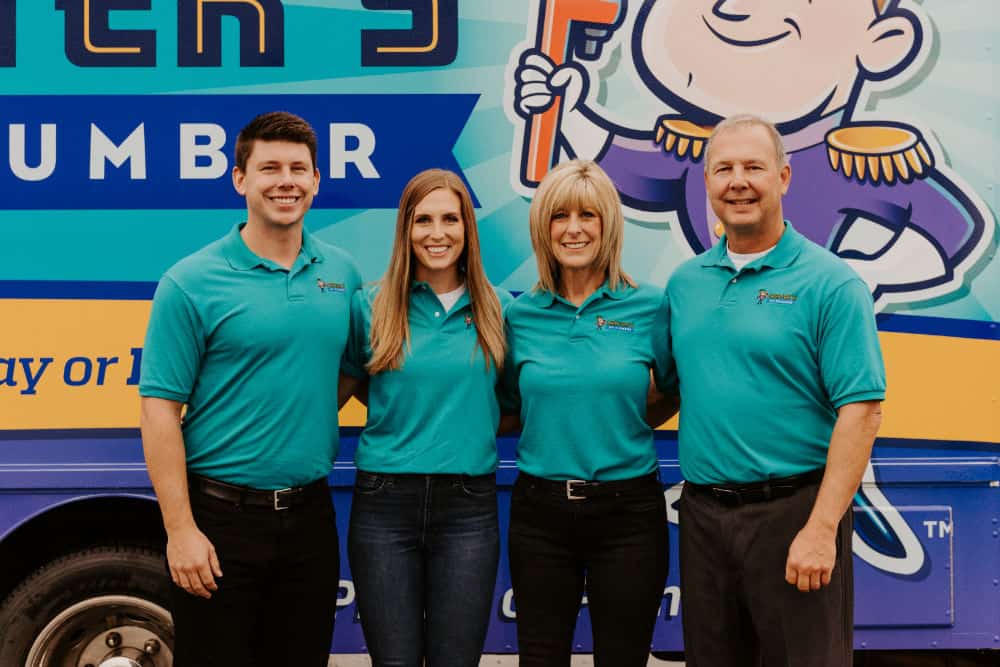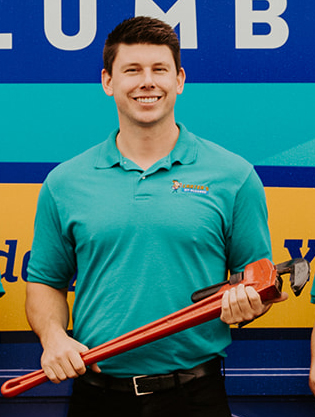Table of Contents
Don’t let your holiday season be ruined by these holiday plumbing problems.
Practice regular maintenance, take preventative action at the first sign of an issue, and if necessary, call an experienced
plumber to repair or replace any problem fixtures before you have a house full of guests and a meal in
the oven! Below are holiday plumbing problems that can go wrong with your plumbing.
No Hot Water.
If there are more people at your house and there is more hot water usage than
usual, your hot water heater might not be able to keep up with its current setting. If your hot water heater
is already performing poorly, consider replacing it with a newer, better, and more energy efficient
model before guests arrive. Check your water heater’s temperature setting and make necessary
adjustments, but do not set above 125 degrees. Plan adequate time between showers, so the water
heater has time to recover. Finally, consult our last article on hot-water-heater
maintenance and issues that arise with water-heater age, and call an experienced plumber to evaluate,
repair, or replace your unit if necessary.
Stopped Up, Drain.
Drain clogs can quickly put a damper on your holiday gathering and can
lead to unexpected costs if they necessitate the services of a plumber on a holiday. Knowing what not
to pour down your drain and garbage disposal can save you big time and prevent headaches. Below are
the main clogging culprits:
- Fats, oils, and grease: When greasy substances get wet, they expand and congeal because they
cannot mix with water, and they cause clogs deep in the plumbing system. Liquid fats and
cooking oils solidify and cause blockages. - Egg shells, nuts, coffee grounds, poultry skin, fruit and vegetable peels, rice, pastry dough,
bones, seeds, and pits: None of these items should ever be inserted in a sink drain or garbage
disposal. - Diapers, dental floss, sanitary napkins, and tampons: These items all clog drains. Even if diapers
claim to be flushable, chances are they are too strong to be disintegrated in the plumbing
system and will cause a clog. Dental floss wraps around waste and prevents it from fully
disintegrating.
If you encounter a clog, you may be able to dislodge it yourself. Many clogs can be dislodged
using a sink plunger, which is smaller and shaped differently than a toilet plunger. To use the sink
plunger, place the plunger over the sink’s drain hole, ensuring enough water at the bottom to form a
seal, then pump the plunger up and down. If that doesn’t work, try pouring hot or near-boiling water
down the drain to break up organic compounds and soap scum within the clog (add baking soda to the
hot water to add more clog-busting power). Avoid using over-the-counter drain-clearing products
because the chemicals in those products are toxic and can corrode drain pipes. If you’ve tried the
methods above and still have a clog, it’s time to call an experienced plumber.
Toilet Gurgles.
Toilet gurgles are caused by air escaping back into the toilet. This is the
first sign of a more serious and costly issue occurring. There are 3 main causes of toilet gurgling:
- There is a blockage in the toilet or drain for that toilet;
- There is a blockage in the vent stack leading to the roof that may have a nest or leaves
in it; - There is a main sewer line blockage.
The main sewer line blockage is the most common. The main sewer line is where all the drains
in the home connect, and it carries all the waste and water out to the city sewer system or to a septic
tank. The obstruction or blockage typically builds slowly, over time. Most homeowners don’t realize
there is a blockage until an issue arises causing property damage. Because the blockage occurs
underground, the only way to become aware of an issue is to wait for a backup to occur or hire a
professional with a sewer camera. As soon as you hear a gurgling toilet, call a professional Indianapolis drain cleaning plumbing company with proper equipment and cameras to determine the cause of the issue and make necessary repairs.
Sump Pump Fails.
Sump pumps are necessary for many homes, yet they frequently fail. The key
to consistent sump pump operation is maintenance. Sump pumps sit in a hole, dug in the lowest part of
the basement or crawlspace, where they filter water from that location, through pipes that run away
from the foundation of the house. Below are the major causes of sump pump failure:
- Power failure: Remedy this with a backup generator that can be manually activated.
Protect your sump pump from power surges with a service entrance surge protection
device. - Wrong size sump pump: An incorrectly sized or improperly installed pump will not
function properly. If it is too big, it will be forced to work harder, shortening its lifespan.
If it is too small, it will be unable to adequately pump out the water, resulting in a
shorter lifespan. - Improper installation: The pump must be installed precisely to avoid severe water
damage. It is best to hire an experienced plumber to install your sump pump. Install a
check valve on the discharge line to prevent back-flow of water, and drill a small air
relief hole in the discharge line between the pump and check valve to prevent the pump
from having to overcome the air pressure in the discharge pipe. Don’t sit your sump
pump in dirt or gravel – this will cause debris to enter the pump, which will interfere
with the pump’s on/off switch or float arm. - Switch problems: The leading mechanical cause of sump pump failure is a switch
problem. This occurs when the pump shifts position inside the basin, rendering the float
ineffective. - Lack of maintenance: Follow our recommended maintenance to ensure your pump is
working to its capacity:
o Run the pump every 2-3 months;
o If you have a backup pump, unplug the primary pump and run your back-up to
ensure proper operation;
o When testing your pump, go outside to ensure the water is discharging
properly;
o Check the operation of the float to make sure it is not restricted;
o Clean the air-hole in the discharge line;
o Listen for unusual noises when the motor is running;
o Replace the battery on the backup sump pump every 2-3 years. - Frozen or clogged discharge lines: If water cannot exit through the discharge line, the
system will not work. It is important to keep the pipe protected from freezing and free
of sticks, dirt, rocks, and other debris. A special grated discharge line attachment placed
near your home on the discharge line will help. This will have openings that give water a
way to flow out of the pipe if the line is blocked further down. - Product defect: Test your pump when it is installed to ensure proper operation.
- If you need help with sump pump repair in Indianapolis don’t hesitate to contact Carter’s My Plumber.
Faucet Drips.
There are four different types of faucets:
- Compression faucet
- Ball-type faucet
- Cartridge faucet
- Ceramic-disk faucet
Each faucet-type encounters different issues and must be repaired differently. Typical reasons
for faucet dripping include corrosion, mineral deposits on internal parts, and defective gaskets, O-rings,
and washers. Most drippy faucet issues can be easily repaired, but ignoring a faulty faucet can turn a
simple repair into a $1,000 project. Additionally, a drippy faucet can lead to over 100 gallons of water
waste every moth – bad for the environment and bad for your wallet. Common causes of drippy faucets
include:
- The O-ring can become loose or wear out over time with regular usage, causing the
faucet to drip near the handle. This problem occurs specifically in cartridge faucets and
replacing the damaged O-ring can fix the issue. - Accumulation of water sediments can cause the valve seat to corrode. This causes
leakage around the spout area and can be prevented by cleaning the valve seat
regularly, with the help of an experienced plumber. - One of the most common causes of a dripping faucet is a worn-out washer. Every time
the faucet is used, the washer is forced against the valve seat, which causes friction and
leads to the washer wearing out. This can be amended by replacing the washer ASAP. - A washer that has been installed improperly or is not the right size can also cause
leakage. This can be remedied simply by replacing the washer with a properly installed,
proper sized washer. - Continuous usage may cause the adjusting ring and packing nuts in the steam screw to
become loose, causing leakage near the faucet handle. If you notice leakage from the
handle, you need to either tighten the packing nut or completely replace it. - Sediment can accumulate inside the faucet assembly, and cause the inlet and outlet
seals to wear out. Hire a plumber to regularly clean the water sediments from the seals
to ensure your faucet mechanism is functioning properly. - A dripping faucet may also be caused by broken pipes or fittings interfering with the
water pressure. If you have exhausted every other remedy and the issue remains, hire
an experienced plumber to check your pipes.
So, there you have it. Those are the 5 things that can go wrong with your plumbing during the
holidays, and a helpful guide to avoiding a catastrophe on the big day. However, if the unforeseen does
occur and you find yourself knee deep in a plumbing emergency with a home full of disgruntled guests,
give Carter’s My Plumber a call and we’ll come out to save the day!



